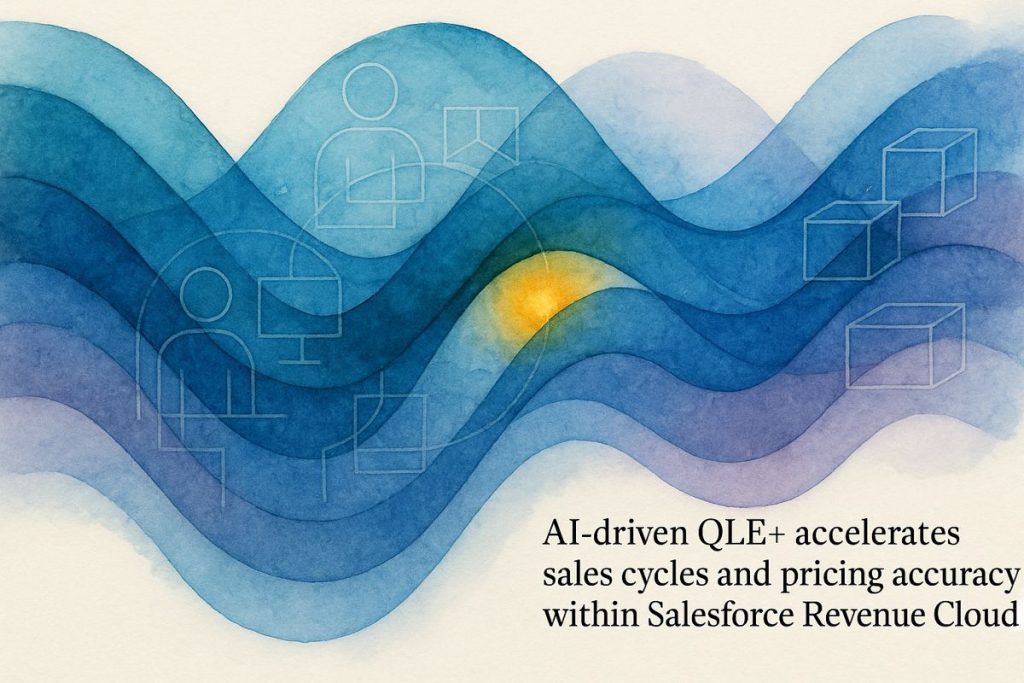QLE+ by B2B-Matrix is an AI-powered app that fits smoothly into Salesforce Revenue Cloud, making quoting smarter and faster. It gives helpful, real-time suggestions and learns from past quotes, so mistakes drop and deals close quicker. The app keeps sensitive info safe, follows strict rules, and lets teams work together easily. With simple setup and flexible design, QLE+ helps businesses big and small upgrade their sales without headaches.
What is QLE+ by B2B-Matrix and how does it enhance Salesforce Revenue Cloud?
QLE+ by B2B-Matrix is a native AppExchange solution that integrates AI-powered quoting directly into Salesforce Revenue Cloud. It streamlines quote creation with intelligent recommendations, real-time analytics, and seamless compliance, reducing quoting errors and cycle times while supporting industry-specific requirements and collaborative workflows.
There’s a certain aroma—espresso meets ozone—that always reminds me of late-night hackathons. That’s the scent that hung in the air the first time I opened QLE+ inside Salesforce Revenue Cloud. Let’s just say, I’ve seen my fair share of “revolutionary” software, so initial skepticism danced on my tongue along with the coffee. Still, B2B-Matrix’s newest release, QLE+, beckoned with the quiet confidence of a tool that knows its own value—no hyperbole, just a glint of hyperspectral promise.
The Anatomy of Seamless Integration
Let’s talk about the bones first. QLE+ drops right onto the Salesforce landscape as a native AppExchange package—none of those awkward bolt-ons that haunt Salesforce admins in their sleep. Built with Apex and Lightning Web Components, it weaves itself into the existing fabric of Revenue Cloud and Salesforce CPQ. This isn’t just technical jargon; it means your admins won’t be gnashing their teeth over version conflicts or botched deployments. In fact, Named Credentials are used for secure API callouts—a choice that’s so elegantly simple, I almost missed it.
I had to stop and ask myself: why isn’t every vendor this considerate? Maybe I’m too used to the Kafkaesque labyrinths of legacy CPQ add-ons. But QLE+ installs with minimal disruption, requiring no arcane sacrifices of managed packages. That, friends, is worth more than a perfunctory press release.
One time, during an implementation sprint for a pharma client, I watched a team lose two days wrestling with a misbehaving integration. If we’d had QLE+ back then, I suspect my inbox would’ve been much quieter—and my stress level, less tectonic.
AI With a Mind (and Memory) of Its Own
The beating heart of QLE+ is its intelligence layer—one that doesn’t just regurgitate templates, but actually thinks . Powered by large language models (LLMs), refined machine learning, and real-time analytics, it’s like having a polymathic colleague perched on your shoulder, whispering contextually nuanced advice as you build a quote.
Here’s where it gets interesting. Instead of a generic “helpful” popup, QLE+ surfaces recommendations—discounts, configurations, price points—right alongside each quote line. The sensory experience is immediate, almost tactile, as if you could reach out and rearrange the deal structure with your fingertips. If you’ve ever tried to forecast revenue with only a spreadsheet and hope, you know that feeling when fresh insight lands—a little jolt, like biting into an unexpectedly tart cherry.
The platform’s guidance is especially vital in regulated industries, say, life sciences or pharmaceutical sales, where a slip in pricing isn’t just embarrassing—it can be catastrophic. According to B2B-Matrix’s own analysis, these context-aware nudges can outpace even the most caffeinated sales teams, reducing errors and accelerating deal velocity. Sounds ambitious, but the early metrics—think 17% decrease in quoting cycle time for one anonymized client—are hard to ignore.
Oh, and the system doesn’t just guess. It learns; it remembers. You won’t find it forgetting last quarter’s pricing anomaly or fumbling a Bill of Materials in the eleventh hour.
Compliance That Feels Like a Feature, Not a Straitjacket
Data privacy and compliance: two words that usually send a chill down my spine, as if someone just ran their nails across a chalkboard. But here, QLE+ turns potential pain into, well, something almost elegant. Sensitive data isn’t simply “handled”—it’s treated like a precious palimpsest, encrypted and accessible only through customer-defined memory layers or embedding-based lookups. Azure OpenAI integration and adherence to life sciences regulatory frameworks? Check.
I’ll admit, I’ve tripped up here before. Once, during a medical device rollout, we discovered too late that sensitive quote details were leaking into non-compliant storage. The aftermath was a bureaucratic fever dream. With QLE+, those guardrails are built in, not bolted on.
Collaboration—which, let’s face it, is usually about as seamless as a lump of granite—gets a serious upgrade. Multi-user, real-time editing on quote lines, audit trails visible at a glance, and interoperability with tools like Google Sheets and Microsoft Excel. The sound of sales teams not shouting across the room? Priceless.
Beyond the Horizon: Extensibility and Industry Context
Now, let’s peer into the future, squinting just a bit. QLE+ isn’t content to rest on its laurels. Thanks to its modular, API-first architecture and cache-enabled interactions, the platform can slip between legacy CPQ systems and the newer Revenue Cloud Architecture like a well-oiled gear. That means you don’t have to rip and replace; you can iterate—faster, lighter, smarter.
This design philosophy is so rare, it feels almost subversive. Most vendors demand a leap of faith. Here, you can tiptoe, experiment, even fail forward (a lesson I learned the hard way in my first botched Salesforce migration—ugh, the memory lingers). And with Salesforce’s own push toward a unified product
